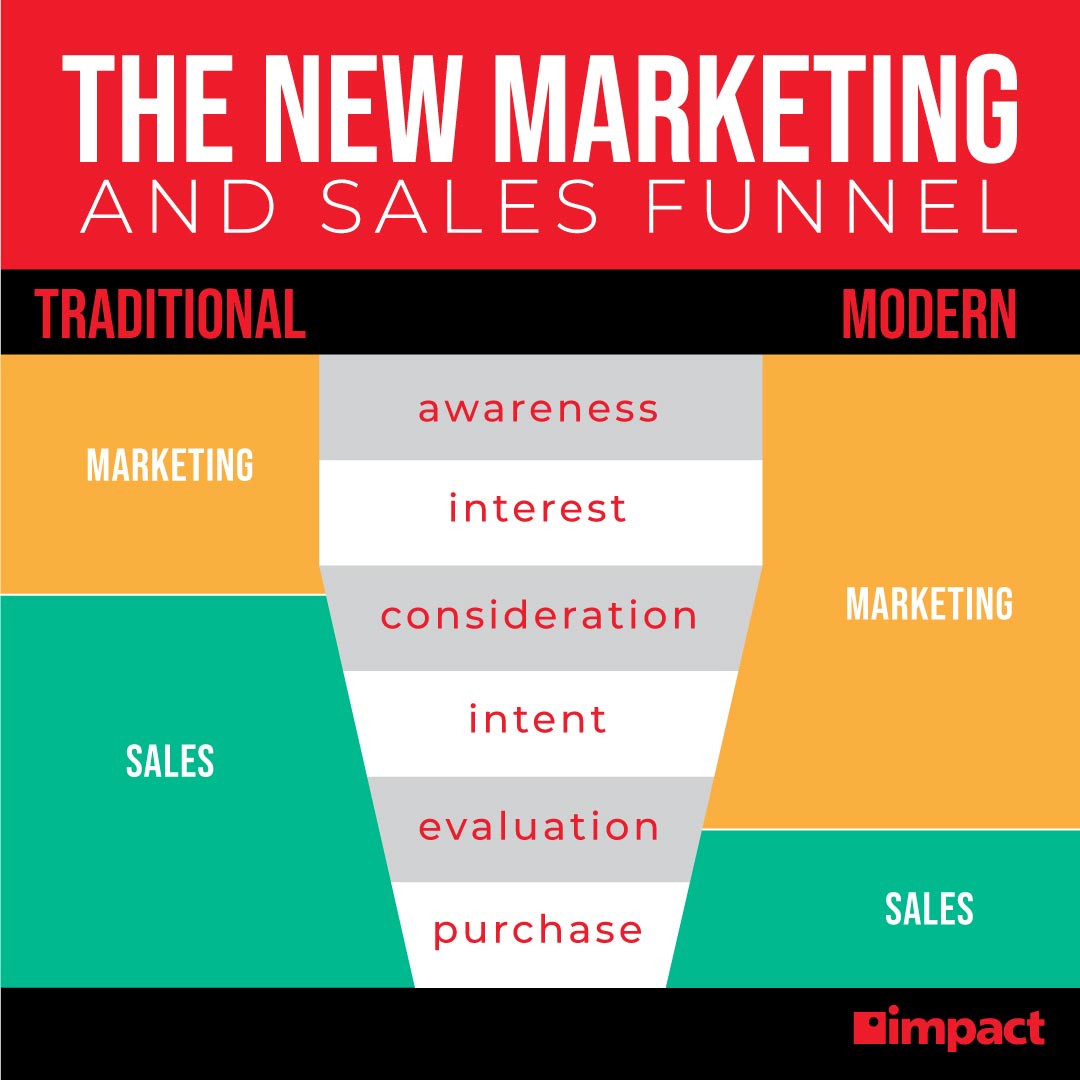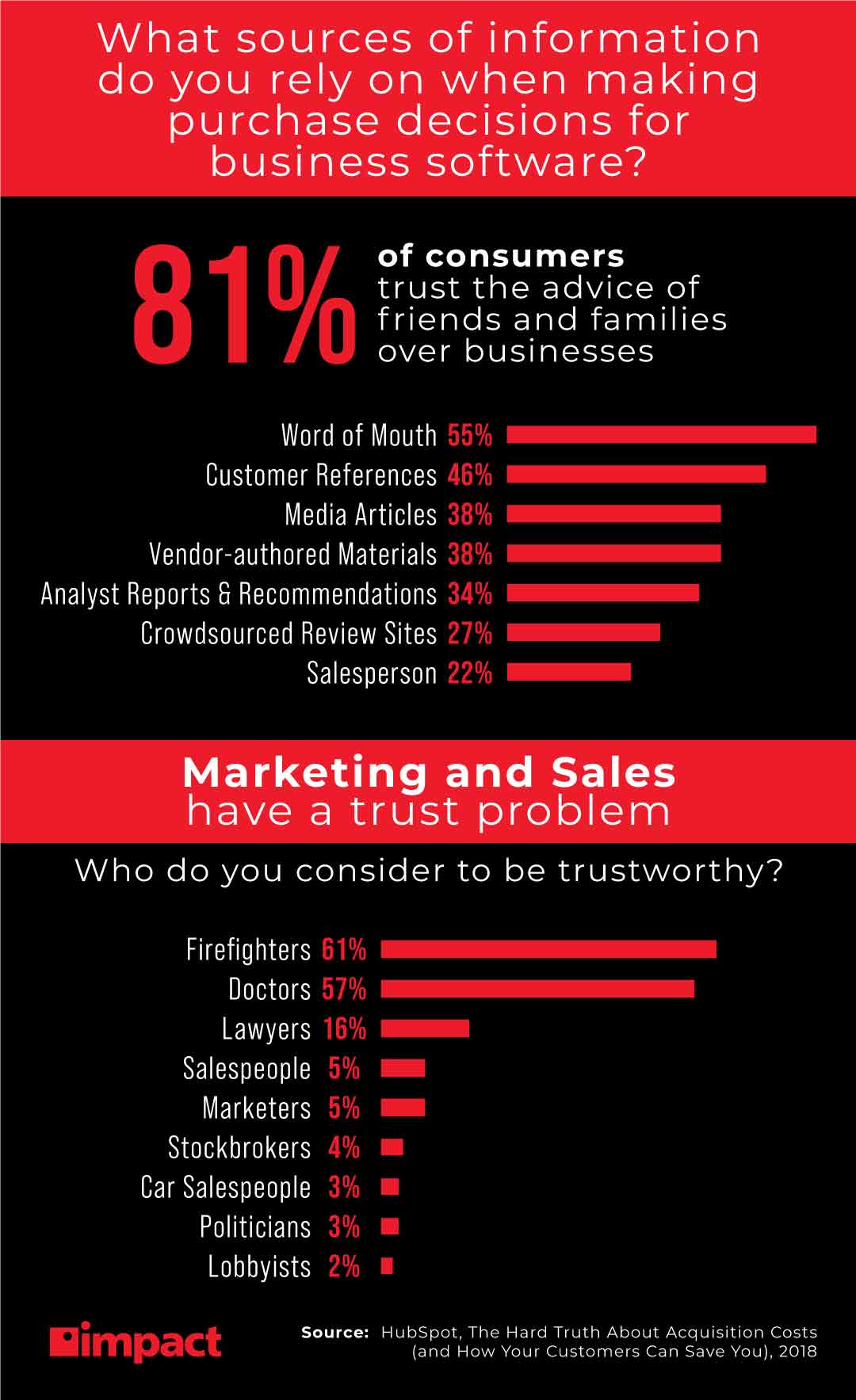While sales and marketing aren’t always considered one –and the same, they certainly go hand-in-hand with one another and share the goal of growing the business and strengthening the bottom line. In that vein, marketing supports a sales engine in what is essentially a symbiotic relationship.
The relationship between sales and marketing mirrors that of the wolf and the raven - only in the business world, marketing guides hungry salespeople to quality prospects.
Understanding marketing as an extension of the sales process helps organizations improve brand awareness, build a well-regarded customer journey, and ultimately strengthen the bottom line.
The marketing strategies we cover below include:
- Outbound Marketing
- Inbound Marketing
- Personalized Marketing
- Third-Party/User Generated Content
- Focus on the Brand Story
Learn how to create memorable marketing campaigns that give your brand some sizzle and improve your market share in Impact’s webinar, Attract, Engage, Stand Out – Building Effective Marketing Campaigns.
Marketing and Sales: A Symbiotic Relationship
By its very nature, marketing is designed to support and improve the sales process. From creating collateral for sales calls and increasing brand awareness through advertising campaigns to establishing the company as an industry authority and using social media to make consumers fall in love with the brand – everything marketing does supports sales directly or indirectly.
In short, marketing supports the sales process by bringing higher quality prospects in the door who are closer to the point of purchase. This symbiotic relationship can be seen in the graphic below, which details how involved marketing is in moving prospects through the sales funnel until they’re ready to sign on the dotted line.
Creating harmony between marketing and sales is especially important when thinking about how people consume content in the modern age. Simply put, you want the messaging in your marketing materials to be as aligned as possible with the language and messaging that salespeople use in conversations with prospects and clients.
If there’s a major disconnect between the two, it can lead to disappointed customers who feel misled, internal frustrations for the organization, and ineffective marketing campaigns that fail to generate leads and conversions.
Creating a Comprehensive Marketing Strategy that Fuels Sales
A marketing strategy is a long-term plan to accomplish specific goals by reaching and engaging your audience. Marketing tactics, on the other hand, are the measures you take and tools you use to reach those goals.
Another way to think about it is that marketing strategy is about planning out where you want to go, and marketing tactics are how you plan to actually get there.
A team may employ any number of tactics, but typically has a single overarching marketing strategy.
For instance, if a company decides to focus on brand awareness by saturating the market with its product and logo, that would be its strategy. To do this, though, they can leverage any number of tactics aimed at brand awareness like advertising, influencer marketing, content marketing, affiliate marketing, product placement, and sponsorships.
Once you have a strategy in place, you can start choosing the specific tactics on which you want to focus in order to execute and realize the vision behind the strategy.
Marketing Strategies Designed to Boost Sales
Different marketing strategies may have slightly different requirements when it comes to execution. It's for that reason that it’s considered best practice to clearly define the core strategy before executing any one tactic.
It’s also important to keep your budget in mind when crafting your marketing strategy and choosing tactics. An ideal marketing strategy will fit well within your budget, be tailored to your specific goals, and should ultimately drive business growth.
1. Outbound Marketing
Reach out to customers and meet them where they are using an outbound marketing strategy. This is traditional marketing; it means getting your brand in front of someone who is not actively seeking it.
This marketing strategy is effective for increasing sales when your ideal audience might not be aware that a solution to their pain points exists, or you need to see results right away.
However, you don’t want to cast too wide a net and send your message out to just anyone. Using research to find the people who would actually get value from your website or contact information instead of just being annoyed by your message is crucial.
Outbound marketing tactics:
- Print, TV, and radio ads
- Cold calling or cold emailing
- Trade shows
2. Inbound Marketing
The flip side of outbound marketing is an inbound marketing strategy. It increases sales by ensuring that the people who want exactly what you have to offer can find you. You can even help people who need you but don’t know it yet find you by focusing on education. Nobody wants to be sold to, but when inbound marketing is done right, your customers will sell themselves on your products and services.
Keep in mind the new marketing and sales funnel. This marketing strategy is designed for it, with assets that help people become aware of the solution to their problem, consider your brand, and evaluate purchasing.
Inbound marketing takes a longer time to start up and see results with than outbound; it may not be for you if you need to get to a sale fast. It involves a ton of content creation and search engine optimization to get people to find your website in the first place. However, if you’re patient, you can reliably make sales go up at a lower cost.
Inbound marketing tactics:
3. Personalized Marketing
Nobody wants to feel like they’re just a number. That’s where personalized marketing comes in. 80% of consumers are more likely to buy from a company that provides an experience that’s tailored to them, and 72% of consumers won’t even engage with your marketing unless it’s personalized. And when you implement this marketing strategy, sales do increase; personalized marketing has a 20:1 ROI.
This strategy uses a combination of inbound and outbound tactics combined with heavy research and audience segmentation to be ultra-precise in who you target with your messaging. That makes it more complex than other marketing strategies, but automation and other MarTech platforms can help you simplify these processes so they’re achievable even for SMBs.
Personalized marketing tactics:
- Segmented email marketing
- Programmatic advertising
- Chatbots
- Cookies for website personalization
4. Third-Party/User Generated Content
Sales and marketing are among the least trusted professions today, making customer acquisition particularly difficult. Where your audience used to turn to you for information and education, they now actively distrust anything a business has to tell them.
That’s why focusing on what other people have to say about your brand through case studies and testimonials on your site, and user reviews and press mentions on other sites can be an effective marketing strategy to increase sales. Instead of forcing your message on someone who may not be interested in it, you simply shine a light on satisfied customers.
Third-party content tactics:
- Public relations
- Highlighting reviews from sites like Yelp or TrustPilot
- Content marketing (for case studies)
- Social media contests
5. Focus on the Brand Story
Until they present a prospect with a contract, your salespeople aren’t performing the functions of sales; they’re the most high-value marketing your organization has. They reach out to your ideal audience, personalize their message, keep the brand top-of-mind, and more. That’s why aligning both teams is one of the most cost-effective and crucial marketing strategies a business can implement to increase sales.
This qualifies as a strategy rather than a tactic because it’s ongoing, consistently evolving, and involves multiple deliverables to execute properly. By regularly ensuring leadership agrees on what the focus of your brand is and that their teams are all telling the same story in client meetings, on a well-designed website, and beyond, you make your business clear and accessible for customers as well.
Brand story tactics:
- Website
- Content marketing
- Brand messaging
- Sales collateral
- Sales training
Embracing MarTech to Improve Processes for Sales and Marketing
Marketing technology makes bringing marketing and sales together even easier, turning the loose relationship into a fully data-driven partnership. By integrating customer relationship management (CRM), automation, and analytics tools, martech ensures that marketing efforts directly support sales goals.
With real-time insights into lead behavior, personalized outreach, and predictive analytics, sales teams receive high-quality, sales-ready leads instead of cold prospects. This alignment minimizes friction and maximizes efficiency, making both teams more effective.
Beyond efficiency, MarTech fosters better collaboration and trust. Instead of operating in silos, marketing and sales share a unified view of the customer journey, allowing them to refine messaging, adjust strategies, and close deals faster. With clear attribution models, marketing gains recognition for its impact on revenue, while sales can leverage richer data to nurture prospects.
This all makes for a more cohesive, results-driven approach that benefits the business and boosts the bottom line.
Aligning Marketing Strategies and Sales
There’s no one “best” or “correct” marketing strategy to increase sales. The one your organization should go with will depend on the size of your business and your marketing budget, what you offer, who your target audience is, and what resources you can allocate.
Not to mention that as the market changes, it becomes necessary to review your strategy and make sure it’s still aligned with your vision and goals. While these strategies are typically designed to last for years, regular marketing strategy assessments will help you decide when it’s time to make adjustments or pivots.
All in all, measuring metrics regularly and adjusting your strategies based on shifts in the market and shifts to your business is the best way to keep your marketing and sales departments in tune and humming in harmony.
Marketing isn’t just about getting your content or ads in front of the right audience, it’s also about being memorable and the resonance you can create. Learn more about building unique marketing campaigns in Impact’s webinar, Attract, Engage, Stand Out – Building Effective Marketing Campaigns.



